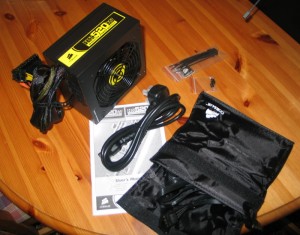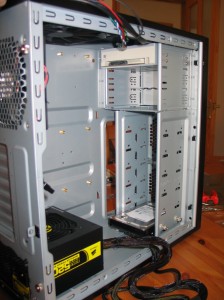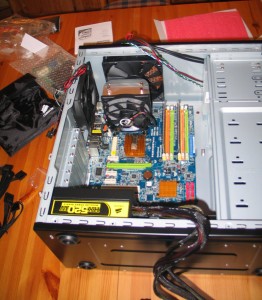Build your own PC Part II
This is the second instalment. If you haven’t already, you’ll probably want to to read the first instalment first.
At the end of the first part of this article, I had installed the main components onto the motherboard, checked out the case and am now ready to start putting it all together.
The first major component to go into the case is the PSU. I purchased a good quality power supply from Corsair that featured modular cabling and a high efficiency and quiet design. The modular cables are a great thing – apart from the main feed to the mobo, everything else you plug in as you need it. This helps to reduce clutter in the case and improves airflow so keeping everything cooler and fans spinning slower.
 In this picture the black pouch toward the bottom contains all the other cables: Sata, Molex, PCI-E and Fans. So once you know what hardware you have to power, you just connect in the cables you need. This is a very neat solution. The PSU itself and the overall presentation was excellent. This really does look the business…
In this picture the black pouch toward the bottom contains all the other cables: Sata, Molex, PCI-E and Fans. So once you know what hardware you have to power, you just connect in the cables you need. This is a very neat solution. The PSU itself and the overall presentation was excellent. This really does look the business…
After looking at it for a while, it was time to fit it into the case. Nothing too hard about that. It did require installing “upside down” as the there is no ventilation underneath where the PSU sits. The Antec Three Hundred manual suggests that the PSU should go in the other way up to help airflow. So be it.  You can also see that I have bolted in the CD/DVD drive (at the top) and the HDD at the bottom of the case.
You can also see that I have bolted in the CD/DVD drive (at the top) and the HDD at the bottom of the case.
That’s about it for the extra bits. There are plenty of spaces for extra Hard drives or 5 1/2″ units like another CD or a multi-card reader if I wanted to add them at a later stage.  But for now, I need to offer in the motherboard (but not screw it down just yet) and once again take some time to look at the whole thing and think about the best way to route the cables. This is the part where you shouldn’t rush. Get a coffee and take you time. Think about where your cables need to go, where or how you can tie them out of the way and generally just get a feel for your computer’s internal layout.
But for now, I need to offer in the motherboard (but not screw it down just yet) and once again take some time to look at the whole thing and think about the best way to route the cables. This is the part where you shouldn’t rush. Get a coffee and take you time. Think about where your cables need to go, where or how you can tie them out of the way and generally just get a feel for your computer’s internal layout.
Once I had a good idea about the layout I got some small cable ties and started to get the main bits out of the way. If any cables will run under the motherboard (no problem doing that if it works for you) now is the time to place them down and then screw your mobo into the brass standoffs that you have dutifully screwed into the base already.
You can see here how I’ve started to attached the various cables to the mobo and external drives etc. This is one area where I think the ASrock motherboard is inferior to others I have used in the past. Placing the power connectors where they have means that in almost all installations the cables from the PSU will have to route straight over the top of most of the motherboard. In superior layouts, these power connectors are places nearer the bottom or right hand side of the board to reduce this clutter. However, as the PSU cables are quite stiff and nicely sheathed, they offer little obstruction and are quite a long way up (vertically) from the mobo itself so they do not restrict the airflow from front to back too much at all.
You can see I have the SATA leads from the CD and HDD waiting to be plugged in and tied back. This is whilst I am routing the cables from the front panel down to the headers on the mobo which are along the bottom right edge of the board. Tidying up once all the cables are connected and clipping the cables ties back essentially completes the job.

Here you can see the finished build before I put the cover back on and start to setup the software.
I have read that you can test your mobo, processor and memory on the bench before installing it into the case by connecting your PSU, and a monitor and then shorting the power switch pins on the front-panel header on the motherboard! Whilst I have no doubt this works, I am not convinced of the safety and reliability of such a test so have not done this myself.
With this build, once the physical installation was complete I connected up a keyboard, mouse and monitor and powered the PC on. I was greeted by the ASrock BIOS’s welcome screen and went on from there.
 Here’s Lobsang in all its glory… Well it is a black box with a very small and unobtrusive blue LED on the front at least…
Here’s Lobsang in all its glory… Well it is a black box with a very small and unobtrusive blue LED on the front at least…
I might write about the software install too if I find the time. There are some things worth discussing like partitioning of hardisks (something Windows doesn’t really encourage), BIOS settings and the like. If you are interested, please let me know.
[Update] I have just written up a Part III which does discuss the partitioning scheme I employed on this machine.
I hope you enjoyed this brief write up and found it helpful. I have written both of these articles from Lobsang (this new PC) running on Ubuntu Hardy Heron and now Intrepid Ibex (Alpha 5) and I am very pleased with the performance. It boots really fast compared to my previous computer and it is almost silent now I have worked out how to slow the CPU cooler fan down 🙂




Enjoyed the article. I’m putting together a machine, mainly to hook up loads of monitors (cos i can) but the the whole os partitioning thing is an interesting discussion. I’d like to see it at some point
@Barmy,
Thanks for dropping by.
OK. I’ll put together a short piece on the way I like to do partitioning. I must say it has simplified a great deal over the past couple of years…
If you look at this article I wrote just over a year ago, you will see I had quite a complicated partitioning scheme in mind for my little server: http://www.theopensourcerer.com/2007/09/08/untangle-asterisk-pbx-and-file-server-all-in-one/.
Fortunately, I simplified it quite a bit after thinking about it and before I actually built the thing.
But now I use an even simpler scheme…
[…] Build your own PC Part III Although somewhat belatedly, here is a brief discussion on what has happened since I finished building Lobsang. […]